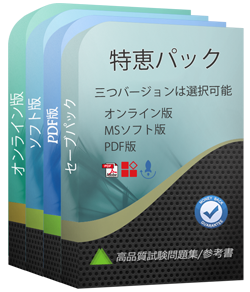あなたは70-516試験参考書の更新をどのぐらいでリリースしていますか?
すべての試験参考書は常に更新されますが、固定日付には更新されません。弊社の専門チームは、試験のアップデートに十分の注意を払い、彼らは常にそれに応じて70-516試験内容をアップグレードします。
Tech4Examはどんな試験参考書を提供していますか?
テストエンジン:70-516試験試験エンジンは、あなた自身のデバイスにダウンロードして運行できます。インタラクティブでシミュレートされた環境でテストを行います。
PDF(テストエンジンのコピー):内容はテストエンジンと同じで、印刷をサポートしています。
70-516テストエンジンはどのシステムに適用しますか?
オンラインテストエンジンは、WEBブラウザをベースとしたソフトウェアなので、Windows / Mac / Android / iOSなどをサポートできます。どんな電設備でも使用でき、自己ペースで練習できます。オンラインテストエンジンはオフラインの練習をサポートしていますが、前提条件は初めてインターネットで実行することです。
ソフトテストエンジンは、Java環境で運行するWindowsシステムに適用して、複数のコンピュータにインストールすることができます。
PDF版は、Adobe ReaderやFoxit Reader、Google Docsなどの読書ツールに読むことができます。
あなたのテストエンジンはどのように実行しますか?
あなたのPCにダウンロードしてインストールすると、Microsoft 70-516テスト問題を練習し、'練習試験'と '仮想試験'2つの異なるオプションを使用してあなたの質問と回答を確認することができます。
仮想試験 - 時間制限付きに試験問題で自分自身をテストします。
練習試験 - 試験問題を1つ1つレビューし、正解をビューします。
割引はありますか?
我々社は顧客にいくつかの割引を提供します。 特恵には制限はありません。 弊社のサイトで定期的にチェックしてクーポンを入手することができます。
購入後、どれくらい70-516試験参考書を入手できますか?
あなたは5-10分以内にMicrosoft 70-516試験参考書を付くメールを受信します。そして即時ダウンロードして勉強します。購入後に70-516試験参考書を入手しないなら、すぐにメールでお問い合わせください。
更新された70-516試験参考書を得ることができ、取得方法?
はい、購入後に1年間の無料アップデートを享受できます。更新があれば、私たちのシステムは更新された70-516試験参考書をあなたのメールボックスに自動的に送ります。
返金するポリシーはありますか? 失敗した場合、どうすれば返金できますか?
はい。弊社はあなたが我々の練習問題を使用して試験に合格しないと全額返金を保証します。返金プロセスは非常に簡単です:購入日から60日以内に不合格成績書を弊社に送っていいです。弊社は成績書を確認した後で、返金を行います。お金は7日以内に支払い口座に戻ります。
Microsoft TS: Accessing Data with Microsoft .NET Framework 4 認定 70-516 試験問題:
1. You use Microsoft Visual Studio 2010 and Microsoft .NET Framework 4.0 to create an application.
The application connects to a Microsoft SQL Server database. The application uses the ADO.NET Entity
Framework to model entities. The database includes objects based on the exhibit. (Click the Exhibit
button.)
The application includes the following code segment. (Line numbers are included for reference only.)
01 using (AdventureWorksEntities advWorksContext = new AdventureWorksEntities
()){
02 ...
03 }
You need to retrieve a list of all Products from todays sales orders for a specified customer.
You also need to ensure that the application uses the minimum amount of memory when retrieving the list.
Which code segment should you insert at line 02?
A) Contact customer = context.Contact.Where("it.ContactID = @customerId", new ObjectParameter("customerId", customerId)).First(); customer.SalesOrderHeader.Load(); foreach (SalesOrderHeader order in customer.SalesOrderHeader) {
if (order.OrderDate.Date == DateTime.Today.Date)
{
order.SalesOrderDetail.Load();
foreach (SalesOrderDetail item in order.SalesOrderDetail)
{
Console.WriteLine(String.Format("Product: {0} ", item.ProductID)); } } }
B) Contact customer = (from contact in context.Contact.Include ("SalesOrderHeader") select contact).FirstOrDefault(); foreach (SalesOrderHeader order in customer.SalesOrderHeader) {
order.SalesOrderDetail.Load();
if (order.OrderDate.Date == DateTime.Today.Date)
{
foreach (SalesOrderDetail item in order.SalesOrderDetail)
{
Console.WriteLine(String.Format("Product: {0} ", item.ProductID)); } } }
C) Contact customer = (from contact in context.Contact.Include ("SalesOrderHeader.SalesOrderDetail") select contact).FirstOrDefault(); foreach (SalesOrderHeader order in customer.SalesOrderHeader) {
if (order.OrderDate.Date == DateTime.Today.Date)
{
foreach (SalesOrderDetail item in order.SalesOrderDetail)
{
Console.WriteLine(String.Format("Product: {0} ", item.ProductID)); } } }
D) Contact customer = context.Contact.Where("it.ContactID = @customerId", new ObjectParameter("customerId", customerId)).First(); customer.SalesOrderHeader.Load(); foreach (SalesOrderHeader order in customer.SalesOrderHeader) {
order.SalesOrderDetail.Load();
if (order.OrderDate.Date == DateTime.Today.Date)
{
foreach (SalesOrderDetail item in order.SalesOrderDetail) { Console.WriteLine(String.Format("Product: {0} ", item.ProductID)); } } }
2. You use Microsoft Visual Studio 2010 and Microsoft .NET Framework 4.0 to create an application.
The application connects to a Microsoft SQL Server database. You use Entity SQL to retrieve data from the
database.
You need to find out whether a collection is empty. Which entity set operator should you use?
A) ANYELEMENT
B) IN
C) EXISTS
D) EXCEPT
3. You use Microsoft Visual Studio 2010 and Microsoft .NET Framework 4.0 to develop an application that
uses the Entity Framework.
You create the following Entity Data Model.
You add the following code fragment:
using(var context = new AdventureWorksLTEntities())
{ Customer cust = context.Customers.First(); cust.CompanyName = "Contoso"; int count = 0;
}
The changes to the cust entity must be saved. If an exception is thrown, the application will attempt to save
up to 3 times.
If not, an exception is thrown. Which code segment should you use?
A) while(count++ < 3)
{
try
{
context.SaveChanges();
break;
}
catch(Exception)
{
}
}
B) while(true)
{ context.SavingChanges += delegate(System.Object o, System.EventArgs e) {
if(count++ >2)
{
throw new Exception();
}
context.SaveChanges();
}
}
C) while(context.ObjextStateManager.GetObjectStateEntry (cust).OriginalValues.IsDBNull(0)) {
if(count++ >2)
{
break;
}
context.SaveChanges();
}
D) while(cust.EntityState == EntityState.Modified)
{
try
{
context.SaveChanges();
}
catch(Exception)
{
if(count++ > 2 && context.Connection.State ==
ConnectionState.Broken
{
throw new Exception();
}
}
}
4. The entity data model must be configured to provide a way you cal the sp_FindObsolete stored procedure. The returned data must implement the Descendants property.
In Visual Studio 2010, you open the Add functions Import dialog box from the EDMX diagram and enter the information shown in the following graphic.
You need to complete the configuration in the dialog box. What should you do?
A) In the Returns a Collection Of area, click Scalars and then, in the Scalars list, click string
B) In the Returns a Collection Of area, click Entities and then, in the Entities list, click Component
C) Click the Get Column Information button, click Create New Complex Type and then, in the Complex box, enter Parts.
D) In the Returns a Collection Of area, click Scalars and then, in the Scalars list, click Int32
5. You use Microsoft Visual Studio 2010 and Microsoft Entity Framework 4.0 to create an application.
The application connects to a Microsoft SQL Server database. You use the ADO.NET LINQ to SQL model
to retrieve data from the database.
The applications contains the Category and Product entities as shown in the following exhibit:
You need to ensure that LINO to SQL executes only a single SQL statement against the database. You also need to ensure that the query returns the list of categories and the list of products.
Which code segment should you use?
Exhibit:
A) using (NorthwindDataContext dc = new NorthwindDataContext()) { dc.DeferredLoadingEnabled = false;
DataLoadOptions dlOptions = new DataLoadOptions();
dlOptions.AssociateWith<Category>(c => c.Products);
dc.LoadOptions = dlOptions;
var categories = from c in dc.Categories
select c;
foreach (var category in categories) { Console.WriteLine("{0} has {1} products", category.CategoryName, category.Products.Count); } }
B) using (NorthwindDataContext dc = new NorthwindDataContext()) { dc.DeferredLoadingEnabled = false;
var categories = from c in dc.Categories
select c;
foreach (var category in categories) { Console.WriteLine("{0} has {1} products", category.CategoryName, category.Products.Count); } }
C) using (NorthwindDataContext dc = new NorthwindDataContext()) { dc.ObjectTrackingEnabled = false;
var categories = from c in dc.Categories
select c;
foreach (var category in categories) { Console.WriteLine("{0} has {1} products", category.CategoryName, category.Products.Count); } }
D) using (NorthwindDataContext dc = new NorthwindDataContext()) { dc.DeferredLoadingEnabled = false;
DataLoadOptions dlOptions = new DataLoadOptions();
dlOptions.LoadWith<Category>(c => c.Products);
dc.LoadOptions = dlOptions;
var categories = from c in dc.Categories select c;
foreach (var category in categories) { Console.WriteLine("{0} has {1} products", category.CategoryName, category.Products.Count); } }
質問と回答:
| 質問 # 1 正解: A | 質問 # 2 正解: C | 質問 # 3 正解: D | 質問 # 4 正解: B | 質問 # 5 正解: D |


 弊社は製品に自信を持っており、面倒な製品を提供していません。
弊社は製品に自信を持っており、面倒な製品を提供していません。



 -樱井**
-樱井**

